因果关系cause-and-effect
- 格式:ppt
- 大小:302.00 KB
- 文档页数:7
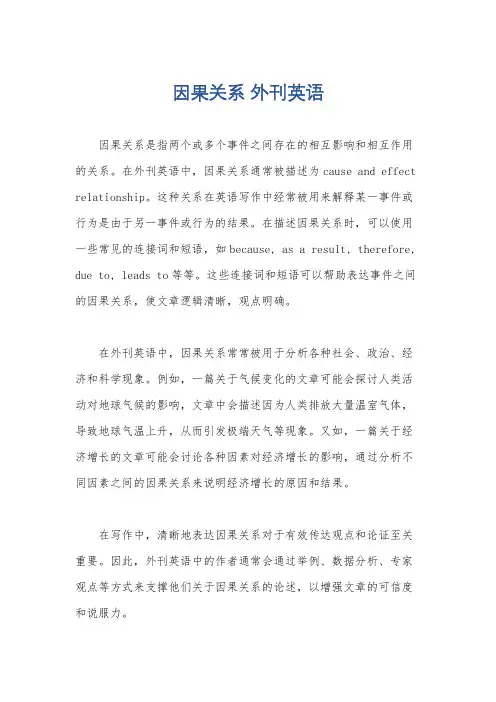
因果关系外刊英语
因果关系是指两个或多个事件之间存在的相互影响和相互作用的关系。
在外刊英语中,因果关系通常被描述为cause and effect relationship。
这种关系在英语写作中经常被用来解释某一事件或行为是由于另一事件或行为的结果。
在描述因果关系时,可以使用一些常见的连接词和短语,如because, as a result, therefore, due to, leads to等等。
这些连接词和短语可以帮助表达事件之间的因果关系,使文章逻辑清晰,观点明确。
在外刊英语中,因果关系常常被用于分析各种社会、政治、经济和科学现象。
例如,一篇关于气候变化的文章可能会探讨人类活动对地球气候的影响,文章中会描述因为人类排放大量温室气体,导致地球气温上升,从而引发极端天气等现象。
又如,一篇关于经济增长的文章可能会讨论各种因素对经济增长的影响,通过分析不同因素之间的因果关系来说明经济增长的原因和结果。
在写作中,清晰地表达因果关系对于有效传达观点和论证至关重要。
因此,外刊英语中的作者通常会通过举例、数据分析、专家观点等方式来支撑他们关于因果关系的论述,以增强文章的可信度和说服力。
总之,在外刊英语中,因果关系是一个重要的论述手段,通过清晰地表达事件之间的因果联系,可以帮助读者更好地理解作者的观点和论证,从而更深入地思考和讨论相关议题。
因此,在外刊英语写作中,正确理解和运用因果关系是非常重要的。
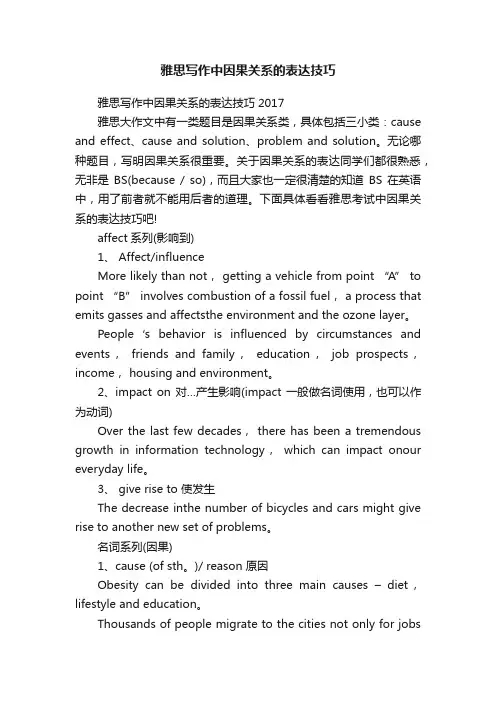
雅思写作中因果关系的表达技巧雅思写作中因果关系的表达技巧2017雅思大作文中有一类题目是因果关系类,具体包括三小类:cause and effect、cause and solution、problem and solution。
无论哪种题目,写明因果关系很重要。
关于因果关系的表达同学们都很熟悉,无非是BS(because / so),而且大家也一定很清楚的知道BS在英语中,用了前者就不能用后者的道理。
下面具体看看雅思考试中因果关系的表达技巧吧!affect系列(影响到)1、 Affect/influenceMore likely than not,getting a vehicle from point “A” to point “B” involves combustion of a fossil fuel, a process that emits gasses and affectsthe environment and the ozone layer。
People‘s behavior is influenced by circumstances and events,friends and family,education,job prospects,income, housing and environment。
2、impact on 对…产生影响(impact 一般做名词使用,也可以作为动词)Over the last few decades, there has been a tremendous growth in information technology,which can impact onour everyday life。
3、 give rise to 使发生The decrease inthe number of bicycles and cars might give rise to another new set of problems。
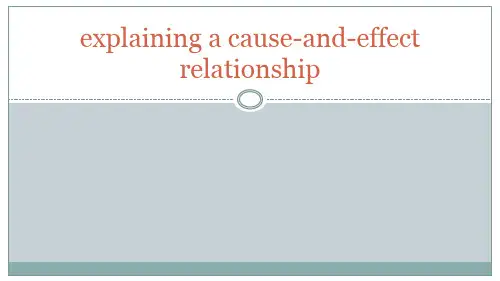
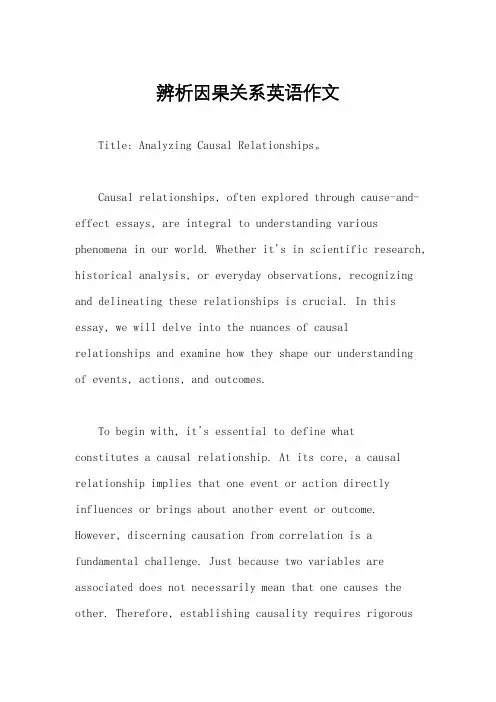
辨析因果关系英语作文Title: Analyzing Causal Relationships。
Causal relationships, often explored through cause-and-effect essays, are integral to understanding various phenomena in our world. Whether it's in scientific research, historical analysis, or everyday observations, recognizing and delineating these relationships is crucial. In this essay, we will delve into the nuances of causalrelationships and examine how they shape our understandingof events, actions, and outcomes.To begin with, it's essential to define whatconstitutes a causal relationship. At its core, a causal relationship implies that one event or action directly influences or brings about another event or outcome. However, discerning causation from correlation is a fundamental challenge. Just because two variables are associated does not necessarily mean that one causes the other. Therefore, establishing causality requires rigorousanalysis and evidence.One common approach to analyzing causal relationshipsis the use of controlled experiments. In scientific research, researchers manipulate one variable while keeping all other factors constant to observe the effects on another variable. This method allows for the identification of causal relationships with a high degree of certainty. For example, in a study investigating the effects of a new drug on a particular medical condition, participants may be randomly assigned to receive either the drug or a placebo. By comparing the outcomes between the two groups, researchers can determine whether the drug indeed causes improvements in the condition.Moreover, causal relationships are often explored through observational studies, especially in fields where controlled experiments are impractical or unethical. In such studies, researchers observe naturally occurring phenomena and attempt to identify potential causal links based on correlations and statistical analyses. While observational studies cannot establish causality asconclusively as controlled experiments, they still play a crucial role in generating hypotheses and guiding further research.In addition to scientific inquiry, causal relationships are also central to understanding historical events and societal dynamics. Historians often seek to uncover the causal factors behind significant events such as wars, revolutions, and economic crises. By examining primary sources, analyzing social, political, and economic conditions, and considering the actions of key individuals or groups, historians construct narratives that elucidate the causal chains leading to particular outcomes.Furthermore, in everyday life, we constantly navigate causal relationships to make sense of our experiences and decisions. From personal relationships to professional endeavors, understanding the consequences of our actions is essential for making informed choices and planning for the future. For instance, if a student performs poorly on an exam, they may reflect on the causal factors behind their performance, such as inadequate preparation, distractions,or lack of understanding of the material. By identifying these causal factors, the student can take corrective actions to improve their performance in the future.However, it's essential to recognize that causality is not always straightforward. Complex systems often involve multiple interconnected factors, feedback loops, and nonlinear relationships, making it challenging to isolate individual causes and effects. Moreover, causal relationships can be influenced by contextual factors, cultural norms, and historical contingencies, further complicating our understanding.In conclusion, causal relationships are fundamental to our understanding of the world around us, whether in scientific research, historical analysis, or everyday life. By rigorously analyzing evidence, conducting experiments, and considering contextual factors, we can unravel the intricate causal chains that shape events, actions, and outcomes. Despite the complexities involved, the pursuit of understanding causality remains a central endeavor in human inquiry and scholarship.。
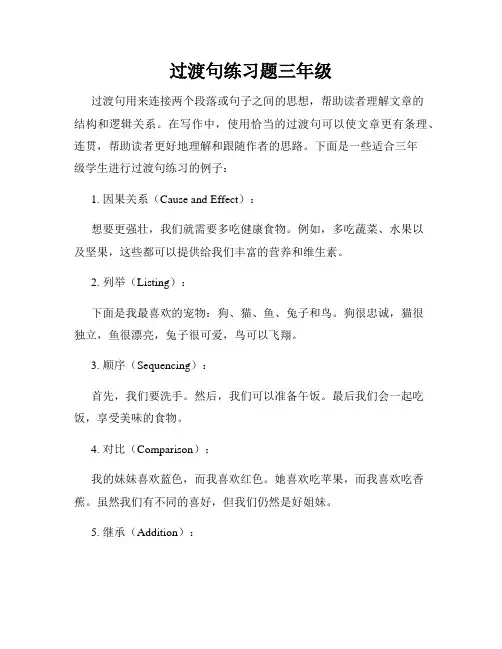
过渡句练习题三年级过渡句用来连接两个段落或句子之间的思想,帮助读者理解文章的结构和逻辑关系。
在写作中,使用恰当的过渡句可以使文章更有条理、连贯,帮助读者更好地理解和跟随作者的思路。
下面是一些适合三年级学生进行过渡句练习的例子:1. 因果关系(Cause and Effect):想要更强壮,我们就需要多吃健康食物。
例如,多吃蔬菜、水果以及坚果,这些都可以提供给我们丰富的营养和维生素。
2. 列举(Listing):下面是我最喜欢的宠物:狗、猫、鱼、兔子和鸟。
狗很忠诚,猫很独立,鱼很漂亮,兔子很可爱,鸟可以飞翔。
3. 顺序(Sequencing):首先,我们要洗手。
然后,我们可以准备午饭。
最后我们会一起吃饭,享受美味的食物。
4. 对比(Comparison):我的妹妹喜欢蓝色,而我喜欢红色。
她喜欢吃苹果,而我喜欢吃香蕉。
虽然我们有不同的喜好,但我们仍然是好姐妹。
5. 继承(Addition):我喜欢阅读,还喜欢写作。
阅读可以帮助我学到很多新知识,写作则是表达我自己的想法和感受的一种方式。
6. 引用(Quoting):大人们常说:“早睡早起,身体好”。
这句话意味着我们应该每天早点睡觉,早上早起,这样我们才会保持健康和精力充沛。
7. 解释(Explanation):春天是一个温暖而美丽的季节。
在春天,花朵开始绽放,树木变绿,小鸟开始歌唱。
人们喜欢春天,因为它充满了生机和希望。
8. 强调(Emphasis):我们要记住:友谊是宝贵的。
朋友可以在我们伤心的时候安慰我们,在我们开心的时候分享我们的喜悦。
拥有朋友是一件幸福的事情。
这些例子可以帮助三年级学生熟悉各种类型的过渡句,并在写作中应用。
通过多练习,他们将能够更好地使用过渡句,使自己的文章更加流畅和有条理。

因果关系法英语作文Cause-and-Effect Essay.English Answer:In the intricate tapestry of life, events are intertwined in a cause-and-effect relationship. Understanding this relationship is crucial for comprehending the consequences of our actions and predicting future outcomes. A cause is an event or action that triggers a subsequent event or outcome, known as the effect. This relationship is not merely a linear progression but often involves multiple interconnected causes and effects, forming a complex web of causality.Establishing causality requires careful analysis and consideration of multiple factors. Correlation does not equate to causation, and coincidental occurrences or spurious relationships can obscure the true cause-and-effect dynamics. Researchers employ rigorous methods, suchas controlled experiments, observational studies, and statistical analysis, to determine the direction and strength of the causal relationship.Identifying causes and predicting effects empowers individuals and societies to make informed decisions, mitigate potential risks, and harness opportunities. In the realm of science, understanding cause-and-effect relationships has led to advancements in medicine, technology, and our understanding of the natural world. In social and behavioral sciences, grasping the causes of social phenomena enables us to develop effective policies and interventions to address societal challenges.However, establishing causality can be a complex and elusive endeavor. Unforeseen variables, hidden biases, and the complexities of human behavior can introduce uncertainty into the process. Therefore, it is essential to approach cause-and-effect analysis with a critical mindset, acknowledging the limitations of our knowledge and the potential for alternative explanations.中文回答:因果关系法的定义。
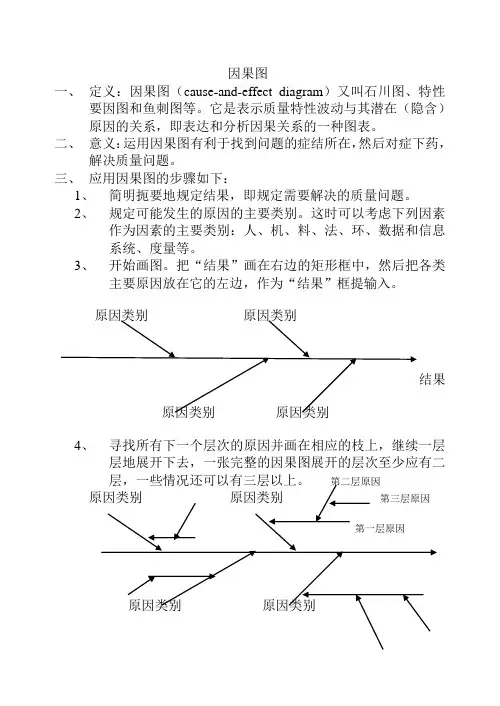
因果图
一、定义:因果图(cause-and-effect diagram)又叫石川图、特性
要因图和鱼刺图等。
它是表示质量特性波动与其潜在(隐含)原因的关系,即表达和分析因果关系的一种图表。
二、意义:运用因果图有利于找到问题的症结所在,然后对症下药,
解决质量问题。
三、应用因果图的步骤如下:
1、简明扼要地规定结果,即规定需要解决的质量问题。
2、规定可能发生的原因的主要类别。
这时可以考虑下列因素
作为因素的主要类别:人、机、料、法、环、数据和信息
系统、度量等。
3、开始画图。
把“结果”画在右边的矩形框中,然后把各类
主要原因放在它的左边,作为“结果”框提输入。
原因类别原因类别
结果
原因类别原因类别
4、寻找所有下一个层次的原因并画在相应的枝上,继续一层
层地展开下去,一张完整的因果图展开的层次至少应有二
层,一些情况还可以有三层以上。
第二层原因
原因类别原因类别第三层原因
第一层原因
原因类别原因类别
四、画因果图应注意以下事项:
1、画因果图时必须开“诸葛亮会”,充分发扬民主,各抒已见,
集思广益,把每个人的意见都一一记录在图上。
2、确定要分析的主要质量问题(特性)不能笼统,一个主要
质量问题只能画一张因果图;因果图只能用于单一目标的
分析。
3、因果关系的层次要分明,最高层次的原因应寻求到可以直
接采取对策为止。
4、对分析出来的所有末端原因,都应该到现场进行观察、测
量、试验等,加以确认。
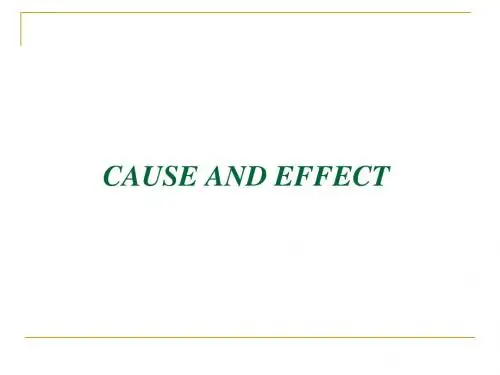
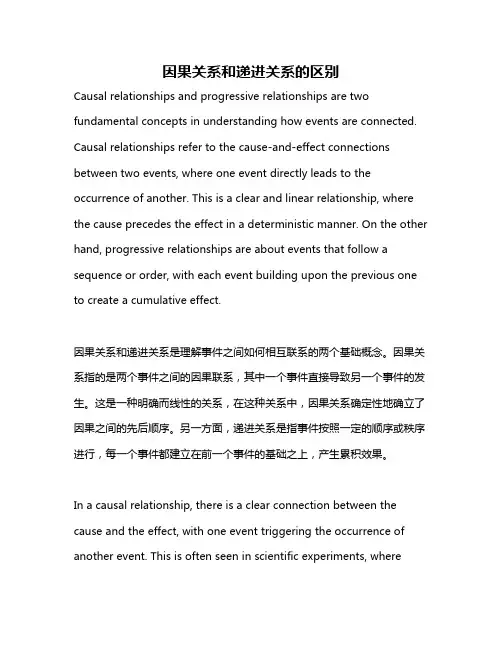
因果关系和递进关系的区别Causal relationships and progressive relationships are two fundamental concepts in understanding how events are connected. Causal relationships refer to the cause-and-effect connections between two events, where one event directly leads to the occurrence of another. This is a clear and linear relationship, where the cause precedes the effect in a deterministic manner. On the other hand, progressive relationships are about events that follow a sequence or order, with each event building upon the previous one to create a cumulative effect.因果关系和递进关系是理解事件之间如何相互联系的两个基础概念。
因果关系指的是两个事件之间的因果联系,其中一个事件直接导致另一个事件的发生。
这是一种明确而线性的关系,在这种关系中,因果关系确定性地确立了因果之间的先后顺序。
另一方面,递进关系是指事件按照一定的顺序或秩序进行,每一个事件都建立在前一个事件的基础之上,产生累积效果。
In a causal relationship, there is a clear connection between the cause and the effect, with one event triggering the occurrence of another event. This is often seen in scientific experiments, whereresearchers manipulate an independent variable to observe its effect on a dependent variable. The cause in this relationship is seen as the independent variable, while the effect is the dependent variable that is influenced by the cause. This deterministic relationship helps researchers establish patterns and predict outcomes based on the established cause-effect relationships.在因果关系中,因与果之间存在着清晰的联系,一个事件触发了另一个事件的发生。
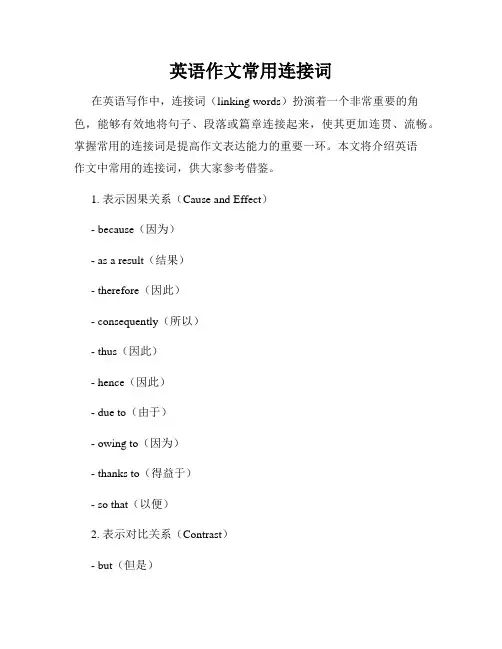
英语作文常用连接词在英语写作中,连接词(linking words)扮演着一个非常重要的角色,能够有效地将句子、段落或篇章连接起来,使其更加连贯、流畅。
掌握常用的连接词是提高作文表达能力的重要一环。
本文将介绍英语作文中常用的连接词,供大家参考借鉴。
1. 表示因果关系(Cause and Effect)- because(因为)- as a result(结果)- therefore(因此)- consequently(所以)- thus(因此)- hence(因此)- due to(由于)- owing to(因为)- thanks to(得益于)- so that(以便)2. 表示对比关系(Contrast)- but(但是)- however(然而)- although(尽管)- whereas(然而)- on the other hand(另一方面)- in contrast(对比而言)3. 表示递进关系(Progression)- furthermore(而且)- moreover(此外)- additionally(另外)- besides(此外)- in addition(另外)4. 表示举例(Example)- for example(例如)- for instance(举例来说)- such as(例如)5. 表示总结(Summary)- in conclusion(总而言之)- to sum up(总结)- in a nutshell(简言之)6. 表示条件关系(Condition)- if(如果)- unless(除非)- in case(万一)- provided that(只要)7. 表示时间关系(Time)- first(首先)- secondly(其次)- then(然后)- next(接下来)- finally(最后)- during(在...期间)- while(当...时候)- as soon as(一...就...)- until(直到)8. 表示解释(Explanation)- in other words(换句话说)- that is to say(也就是说)9. 表示强调(Emphasis)- indeed(确实)- certainly(当然)- without a doubt(毫无疑问)10. 表示引导观点(Introduction)- in my opinion(在我看来)- personally(个人而言)- from my perspective(从我个人的角度来看)以上是英语作文常用的一些连接词,希望能对大家的英语写作有所帮助。
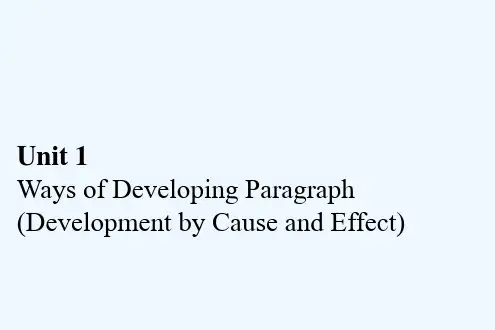
因果关系在英语中被称为"cause and effect"。
它是一种逻辑关系,意味着某个事件(原因)导致了另一个事件的发生(结果)。
在英语中,常常使用一些连词来表达因果关系,例如:
1. because(因为)
This happened because of that.(这是因为那个原因导致的。
)
2. since(既然)
Since you're not feeling well, you should stay at home.(既然你身体不舒服,应该呆在家里。
)
3. as a result(结果)
She forgot to set the alarm clock, as a result, she missed her flight.(她忘记设置闹钟,结果错过了飞机。
)
4. so(所以)
He was tired, so he went to bed early.(他感到疲惫,所以早早上床睡觉了。
)
5. therefore(因此)
The weather was bad, therefore the game was cancelled.(天气不好,因此比赛被取消了。
)
这些词汇和短语可以帮助我们在英语中清晰地表达因果关系,使我们更容易理解和描述事件的发展和结果。
英语阅读理解cause and effect
在英语阅读理解中,cause and effect 是一个常见的题型,主要考察学生理解并分析事件之间因果关系的能力。
这类问题通常会给出一段文章,然后要求回答一些关于事件起因和结果的问题。
要解答这类问题,首先要理解文章中的事件和它们之间的逻辑关系。
通常,cause 是导致某件事情发生的原因,而 effect 是由 cause 引发的一系列后果。
理解这些因果关系需要仔细阅读文章,分析句子之间的联系,以及事件之间的顺序。
回答 cause and effect 问题时,可以从以下几个方面入手:
1. 寻找因果关系的提示词:如 because、since、as、so、therefore、hence 等,这些词可以帮助确定句子之间的因果关系。
2. 分析事件发生的顺序:通常,因果关系中原因先于结果发生,了解事件发生的顺序有助于确定因果关系。
3. 结合上下文语境:有时候,一个事件的原因或结果可能没有明确说明,需要结合上下文语境来推断。
4. 概括总结:如果问题涉及到对整个文章的理解,需要对文章进行概括总结,找出事件之间的主要因果关系。
在回答 cause and effect 问题时,要注意避免过于主观臆断或者遗漏重要信息。
同时,还要注意语言准确性和逻辑性,以确保答案的完整性和准确性。
因果英语单词因果英语单词是指那些描述因果关系的英语单词或短语。
在英语中,有许多单词或短语用于表达因果关系,例如:1. 因果关系 (cause and effect):表示一件事情是由另一件事情引起的,例如:因果关系 (cause and effect):表示一件事情是由另一件事情引起的,例如:- Cause: The heavy rain caused flooding in the city.(暴雨导致城市发生洪水。
)- Effect: The flooding caused damage to homes and businesses.(洪水导致房屋和企业受损。
)2. 结果 (result):表示某事情的结果,例如:- Result: I stayed up too late last night, so I'm tired today.(昨晚我熬夜太晚了,所以今天很累。
)- Result in: Drinking too much alcohol can result in health problems.(喝太多酒可能导致健康问题。
)3. 影响 (impact):表示一件事情对另一件事情产生的影响,例如:- Impact: The new policies will have a significant impact on the economy.(新政策将对经济产生重大影响。
)- Affect: The weather may affect the outcome of the game.(天气可能影响比赛的结果。
)4. 原因 (reason):表示某事情的原因,例如:- Reason: The reason for his absence from work was due to his illness.(他缺席工作的原因是他生病了。
)- Because of: The flight was canceled because of bad weather.(由于天气不好,航班被取消了。